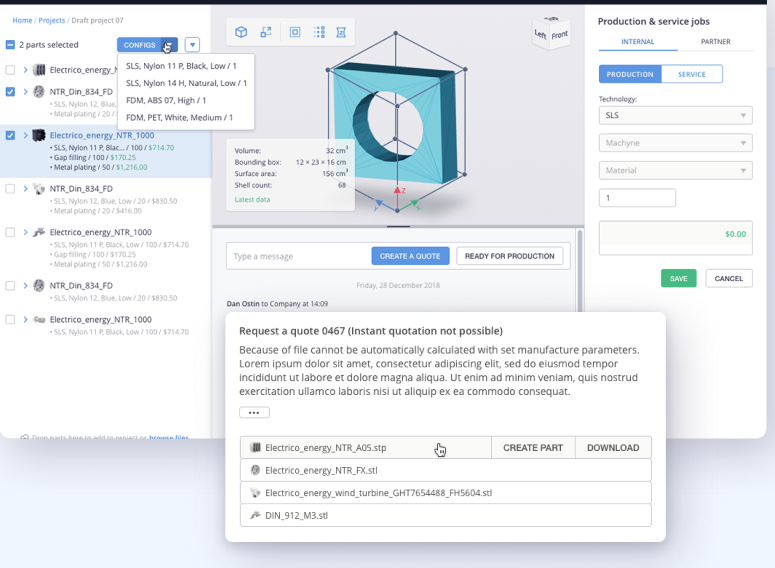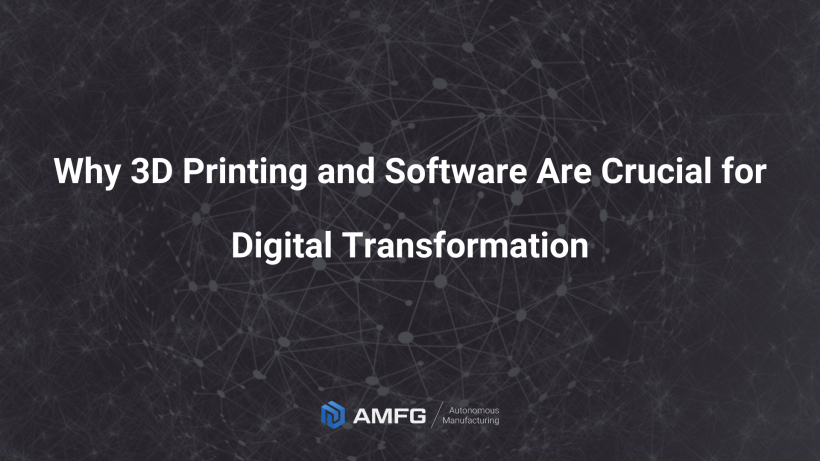COVID-19 has shown the world that traditional supply chains and manufacturing ecosystems must become more adaptable and agile to keep up with changes and challenges brought about by the current crisis.
One solution lies in embracing digital technologies, like 3D printing, also known as additive manufacturing (AM), as part of a drive towards digital transformation.
However, the basis for the successful implementation of both 3D printing and a digital transformation strategy lies in the right software infrastructure.
In this article, we’ll explore the role of software in helping companies that adopt 3D printing to achieve their digital transformation goals.
Additive manufacturing and digital transformation
The manufacturing industry is going through extremely unpredictable times. An ever-evolving consumer landscape, coupled with the current global uncertainty is forcing many manufacturers to reconsider their current strategies.
Taking these factors into consideration, there is a greater push for more agility and automation across manufacturing operations.
To tackle these challenges head on, manufacturers are increasingly turning towards digitisation.
According to the Global Digital Transformation Survey Report 2019 by Fujitsu, 32 per cent of manufacturing companies have already brought about digital transformation, with 40 per cent starting to implement digital transformation initiatives.
Against this backdrop of digitisation, AM is fast becoming a key technology for digital transformation.
To illustrate: in its 5th Annual State of Manufacturing Technology Report 2020, Plex Systems reports 3D printing as being one of the top four emerging technologies adopted for smart manufacturing.
With additive manufacturing, the process of manufacturing a part is controlled by software, making it a highly digitatised process.
4 ways software supports digital transformation with AM
1. Achieving data insights
Data underpins any digital transformation strategy.
To make informed decisions and optimise AM processes, using data effectively should be a priority for companies. Being able to not only collect, but also visualise data helps to better understand and communicate information and creates meaningful and fact-supported insights.
However, deriving insights from data generated at different stages of AM workflow and leveraging it at the right time and the right moment, is only possible when the silos between your manufacturing equipment and software systems are removed.
Establishing a connected workflow can be achieved through MES software, which serves as a centralised platform connecting AM processes.
Connectivity, enabled by MES software, puts data at your fingertips, enabling you to establish a seamless real-time stream of relevant AM data that supports full traceability and agile decision-making.
For example, additive MES software can provide dashboard capability to track and document KPIs related to Overall Equipment Efficiency (OEE), such as machine usage, production output and time to repair.
This, in turn, allows for the optimisation of AM production planning, which is essential for achieving greater operational efficiency.
2. Increasing agility by shifting to digitised processes

Automating manual processes with MES software [Image credit: AMFG]
Manual processes are a significant factor behind long lead times and process inefficiencies. As a result, any digital transformation strategy needs to consider the time and cost impact of automating manual tasks wherever possible.
One way to automate manual processes, like printouts or spreadsheets, is through software.
When it comes to 3D printing, MES software, developed specifically for the needs of the AM production, have appeared on the market over the past several years, to drive workflow automation.
For example, MES software allows you to make the shift towards a single digital platform that automates tasks such as order entry, job costing and production scheduling.
So, instead of manually receiving orders, you can instead provide a centralised, digital platform to automatically receive and standardise orders, provide job costings instantaneously and schedule production through a digital interface.
Workflow automation solutions, like MES software, are crucial pieces of the puzzle of agile AM production, making it future-proofed for scaling as it grows.
3. Unlocking a digital supply chain

Advanced additive MES software can be used to create a digital part inventory [Image credit: AMFG]
As the COVID-19 crisis has shown, rising global uncertainty means that ensuring the resilience of your supply chain is crucial.
One way software can help is by enabling you to implement digital inventory for 3D-printed parts.
Digital inventory is a digital file management system that offers a centralised virtual storage place for your 3D designs and makes them available on demand.
Digital inventories have several benefits, including lower costs for warehousing and logistics, as well as the ability to produce parts on demand, at the point of need.
So if, for example, a part breaks and the original supplier of that part is unable to deliver it on time, 3D printing and digital inventory can provide a solution.
With this combination, a broken part can be replaced much faster by finding its design in a digital inventory, sending it to a 3D printer and having it ready within several hours.
While it sounds futuristic, companies in the transportation, military and maritime sectors are already benefiting from digital inventories enabled by 3D printing.
4. Securing 3D printing data
Any digital transformation technology carries with it potential cybersecurity risks, like theft of Intellectual Property (IP) data. With 3D printing, there is a lot of data transfer, not only between hardware but also between departments, production sites and suppliers.
This means that the ability to protect and securely access 3D printing data from multiple sources becomes more critical than ever.
The good news is that software solutions have been developed specifically for managing 3D printing IP data. Such solutions enable companies to protect and encrypt their proprietary AM designs, as well as material parameters and machine configurations, throughout the entire printing life cycle.
With the right security solutions, companies can achieve the freedom and flexibility they need to succeed in digital manufacturing.
Driving digital manufacturing with software
Software is essential to put your digital transformation with AM on the right track. Software helps to manage data more efficiently and to drive valuable insights and data-based decision-making. It also helps to do away with time-consuming manual tasks by automating AM processes.
Finally, software enables companies to digitise their inventories, providing more flexibility to produce parts on demand, and ensuring that files and other data are secured and traceable.
Establishing the right software infrastructure is only one part of the shift to digital manufacturing. However, it’s a vital step in ensuring that objectives for digital transformation are met.



